
Dianthus is a genus of about 340 species of flowering plants in the family Caryophyllaceae, native mainly to Europe and Asia, with a few species in north Africa and in southern Africa, and one species in arctic North America. Common names include carnation, pink and sweet william.
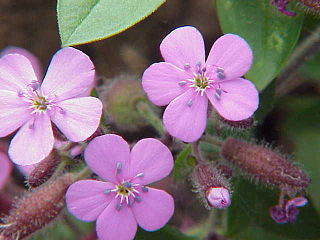
Saponaria is a genus of flowering plants in the family Caryophyllaceae, native to Asia and Europe, and are commonly known as soapworts. They are herbaceous perennials and annuals, some with woody bases. The flowers are abundant, five-petalled and usually in shades of pink or white. The genus is closely related to the genus Silene, being distinguished from these by having only two styles in the flower. It is also related to Gypsophila, but its calyx is cylindrical rather than bell-shaped.

Onopordum, or cottonthistle, is a genus of plants in the tribe Cardueae within the family Asteraceae. They are native to southern Europe, northern Africa, the Canary Islands, the Caucasus, and southwest and central Asia. They grow on disturbed land, roadsides, arable land and pastures.
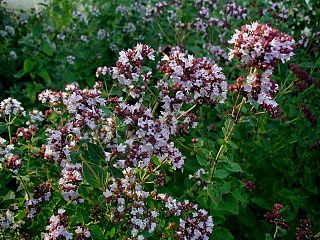
Origanum is a genus of herbaceous perennial flowering plants and subshrubs in the family Lamiaceae. They are native to Europe, North Africa, and much of temperate Asia, where they are found in open or mountainous habitats. A few species also naturalized in scattered locations in North America and other regions.

Petrorhagia is a small genus of annual and perennial plants of the family Caryophyllaceae, mostly native to the Mediterranean region. It is low-growing with wiry stems and narrow, grass-like leaves. The flowers are small, in clusters similar to members of the genus Dianthus, in pink, lilac, or white. Petrorhagia saxifraga is the tunic flower or coat flower, similar to baby's breath, but shorter, and used in rock gardens.
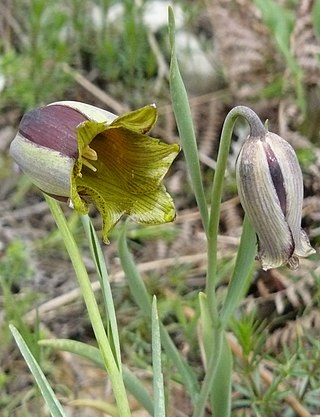
Fritillaria acmopetala, the pointed-petal fritillary, is a species of flowering plant in the lily family Liliaceae, native to rocky limestone mountain slopes in the Middle East. It was described by the Swiss botanist Pierre Edmond Boissier in 1846.
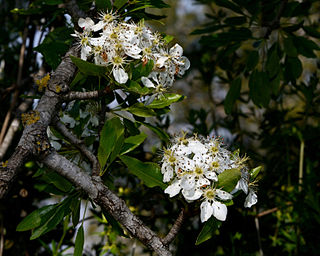
Pyrus syriaca is a deciduous tree in the Rosaceae family. It is referred to by the common name Syrian pear. It is the only pear species which grows in the wild in Lebanon, Turkey, Syria, Israel and Palestine.
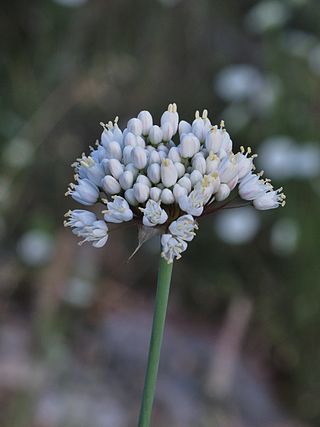
Allium carmeli is a species of perennial in the Amaryllidaceae family. It is found in Israel, Syria and Lebanon.

Allium sindjarense is a species of flowering plant in the Amaryllidaceae family.

Fritillaria gibbosa is a species of herbaceous perennial plant in the lily family Liliaceae. It is native to Afghanistan, Iran, Pakistan, Turkmenistan, and Transcaucasia.

Dianthus strictus, known as the wild pink, is a species of flowering plant in the family Caryophyllaceae.

Dianthus libanotis, the Mount Libanus pink or Lebanon pink, is a herbaceous perennial plant of the family Caryophyllaceae.

Pseudopodospermum libanoticum, also known as Lebanese salsify and Lebanese viper's grass, is a species of perennial plant in the family Asteraceae.

Iris lortetii is a species in the genus Iris. It has straight grey-green leaves, a 30–50 cm tall stem, and large showy flowers in late spring or mid-summer that come in shades of pink, from white, lilac, pale lavender and grey-purple. It is veined and dotted pink or maroon. It has a signal patch that is deep maroon and a sparse and brown, purple-brown or reddish beard.

Crocus ochroleucus is species of flowering plant in the Iridaceae family. It is a cream-colored crocus native to Lebanon, Palestine and Syria.

Astragalus cedreti is a species of flowering plant in the legume family. It is a perennial plant with alternating, smooth pinnate leaves and red flowers. It blooms in June.

Aubrieta libanotica, common name Lebanese rock cress, is a species of flowering plant in the mustard family Brassicaceae. The genus is named after Claude Aubriet, a French flower painter. A. Libanotica is native to the mountainous ranges of Lebanon and some parts of Syria.
Dianthus grossheimii, often called Grossheim's pink or Gvozdika Grossgejma, is native to Turkey and Transcaucasus. It is often found in mountain steppes and meadows.
Trigonella berythea is a plant species in the legume family. It natural habitat is the subtropical biome and endemic to the Eastern Mediterranean.

















